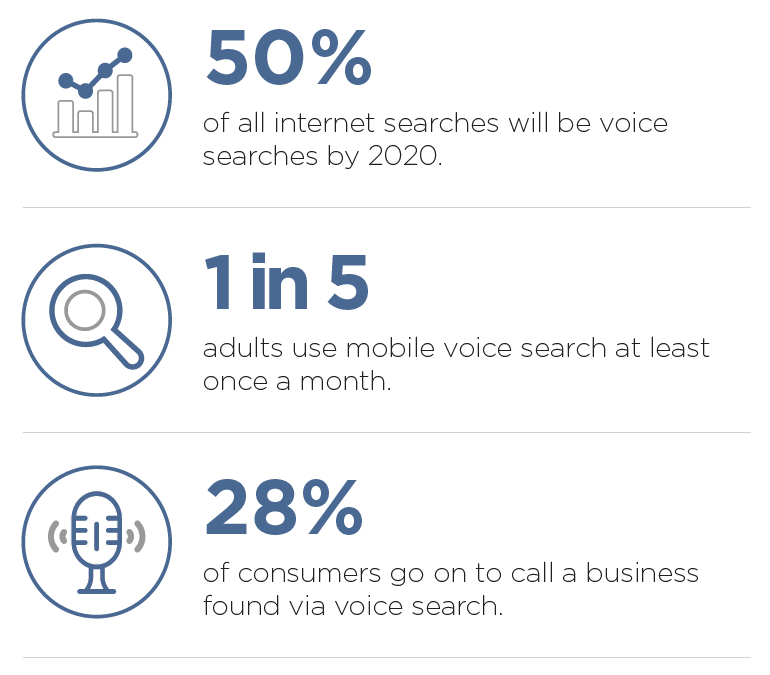It seems like yesterday that the idea of talking to your computer and having it understand you was reserved for TV shows like Star Trek and The Jetsons. But over the past few years, voice technology has become huge, forever changing how we incorporate our devices into our day-to-day lives.
One only needs to look at Google and Amazon, and their forays into the voice command world to see the true impact of this trend.
Google Assistant and Amazon’s Alexa are essentially tiny robots that were developed to integrate into your daily life. They answer your questions, teach you how to do things, and help keep track of your daily activities. They can even make purchases at your command.
These gadgets are also changing the way we search for things on the Web. Where desktop and mobile browsing require us to physically type queries into a search engine, leading to a somewhat stilted syntax (e.g. “Chinese restaurants NYC”), voice search allows us to simply ask. The search query is now an actual question: “Hey Google, where is the closest Chinese restaurant?”
There are currently more than 45 million voice devices in use throughout the United States, and that number is expected to soar in the next year.
So, what does this mean for marketers and how we approach our content?
How Big is Voice Search Getting?
First thing’s first: Voice search is not a fad. It’s a growing trend that is gaining a ton of momentum very quickly.
In fact, more than 30% of all internet browsing is now screenless. Not only that, but voice searches made up for one-third of Google’s 3.5 billion web searches per day in 2017. Experts have also predicted that voice search will account for more than 50% of all internet searches by 2020.

This completely changes the SEO game and how businesses need to start optimizing for voice search. Content now has to be created with screenless searches in mind, which requires a very different approach when compared to text searches.
The question now becomes: “How?”
Get Ranked for Featured Snippets
The first tactic recommended for voice search ranking would be to chase down featured snippets on Google.
A featured snippet is the blurb that pops up at the top of a query's search results, answering the question often without requiring a click.

It’s always a great idea for any SEM strategy to seek out featured snippets, but it becomes even more vital when dealing with voice search.
Because voice search results are relayed verbally to the user, devices read these featured snippets aloud, meaning that the top Google search result is often the main answer given. Furthermore, the answer is often attributed to the source (e.g. "According to the website XYZ.com...").
If you’re able to get your content listed as a featured snippet for a high-value, relevant keyword, you could stand to see a significant increase in both site traffic and overall brand awareness.
Take a More Conversational Tone with Content
If you’re looking to rank for voice search, you’re going to have to adapt your content to a more conversational tone. As we mentioned before, the language used in voice queries differs dramatically from your typical text-based internet search, so the language of the answers needs to match.
A text search might be something like “advertising vs marketing.” A voice query, on the other hand, is usually worded as a casual question like: “What’s the difference between advertising and marketing?”
Because of this difference in syntax, there’s a certain expectation that the answer will also be worded naturally. Not many users will want to sit through Alexa reading an entire treatise from your website, so you may need to adapt your content to be more succinct and bite-sized.
Target Long-Tail Keywords
When trying to rank for voice search results, you also need to target long-tail keywords as opposed to one-word terms. Long-tail keywords are usually three words or more. As with conversational search queries, they’re often whole phrases (if not full sentences or question).
A typical keyword search on desktop might be only one word along with a location modifier. “Brooklyn plumber,” for example, might be something one types into Google while carefully vetting someone to check out their slow-draining tub.
Voice queries, by contrast, are typically issued in a long-tail format. “Okay, Google. My pipes burst, what do I do?” is something one might frantically yell into their Google Home device while water pours from their ceiling.
Historically, long-tail keywords have been easier to rank for, as they are usually very specific and have smaller search volumes than short, generic phrases. Optimizing content to rank for them was thus a strategic numbers game.
But now, content optimization also needs to be about context and understanding how—and why—people search the way they do.
Find Ways to Incorporate Voice Command Services
Of course, incorporating voice into your marketing involves more than just ranking for certain key terms. You can also create actual voice-driven services for your customers, like many of today’s top businesses have been doing over the last few years.
Companies using voice commands as a part of their user experience are increasing their appeal for customers in a more hands-free, mobile-driven world.
For example, Domino’s lets you order pizza with nothing more than your voice. PayPal lets you send money via voice, which allows you to verbally manage financial transactions.

Both of these companies have taken their brands to the next level by enhancing how they fit into the day-to-day lives of their customers—and you can, too.
Figuring out how to incorporate voice into your specific industry could give you a leg up on your competition.
If none of your competitors have hopped on the voice command train yet, be the first to create an enhanced customer experience.
If your competition is already utilizing voice, then you should be working even harder to incorporate it sooner than later, lest you get left behind.
One of the best ways to integrate voice services is by creating a Google Action or Alexa Skill, which are third-party voice apps that add extra functionality to each device. Alexa has more than 70,000 skills, and there are more than 1 million Google Actions. Creating a skill can work to your advantage, as the frameworks of both Alexa and Google Assistant already exist.
This is similar to the app race that began when smartphones were becoming more common. Every company was trying to create its own app on both iOS and Android platforms. That race is on once again, but the arena has changed from smartphones and tablets to the world of voice-assisted programs.
The Key to Longevity is Relevance
You have to stay on top of emerging marketing trends and embrace new technologies as they become available. If you don’t, someone else will. Once everyone gets on board and starts producing voice-optimized content and actions, it will be much harder to get noticed.
Don’t be left in the dust. Embrace the world of voice search today and propel your business into the future—not only for the sake of reach and sales, but for the benefit of the people who want to interact with your brand throughout their day-to-day lives.
.png?width=250&height=153&name=CSI-OverskiesRebrand_LOGO-01(smaller).png)

.png?width=100&height=61&name=CSI-OverskiesRebrand_LOGO-01(smaller).png)


.png?width=88&name=CSI-OverskiesRebrand_LOGO-01(smaller).png)



